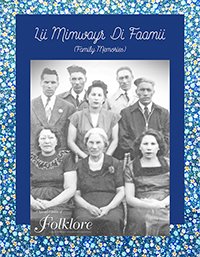Rosalie Lepine and Her Miraculous Cure
This story was originally published in Lii Mimwayr Di Faamii (Family Memories), a compilation of stories from members of Gabriel Dumont Local 11, a Métis Local in Saskatoon, Saskatchewan, Canada. The work began as oral stories, recorded over Zoom during the pandemic. The stories were then transcribed and edited into a Special Edition of Folklore Magazine, published in December 2021.
Lii Mimwayr Di Faamii.
Click below to watch the original video of Wilfred Burton sharing this story:
This is a story about my great grandmother Rosalie Lepine and her Miraculous Cure.
Thanks to my mother for telling us these stories or this story would not live on in my family. My mother, Georgina Nolin, was not well. She had tuberculosis when she was young and she had health issues through most of her life. Often, she’d lay on her bed and we’d lay beside her and she’d tell us stories. This is a story that I remember from my childhood, often told as we lay relaxing on the bed.
Georgina Nolin, mother of Wilfred Burton and granddaughter of Rosalie Lepine and Charles Nolin; daughter of Gabriel Nolin and Eliza Delorme.
My version is not exactly the way my mother told the story because she passed away quite a long time ago when I was much younger. I remember some of the details as was told by her, but I’ve also spoken to other people who added additional details to this story. I’ve done some archival research as well and I’ve visited Our Lady of Lourdes Shrine in St. Laurent, Saskatchewan many times and taken in the documented history there.
Rosalie Lepine was first married to Godfrey Lagimodiere. She had one son, John Baptiste Lagimodiere. Her husband passed away and so she became a widow. My great-grandfather, Charles Nolin, was also a widower. His first wife, who was a first cousin to Louis Riel, died suddenly after the birth of their last child. He was a widower with many children. At that time, men looked for another wife as soon as possible when they were widowed because he had many children to care for. He knew Rosalie was a widow with one child. He married her and adopted her child.
Charles and his new wife proceeded to move west from Red River. They spent a couple winters in the File Hills and then they moved to St. Laurent de Grandin which is just across the river from Batoche and not too far from Duck Lake.
Rosalie Lepine with her husband Charles Nolin.
While in the File Hills a couple of their children were born. When they arrived at St. Laurent, life settled down a bit.
However, the Métis soon became aware of the government’s actions to survey their land contrary to their wishes. Charles and other Métis leaders called upon Louis Riel to return to Canada from the U.S.A.
Charles’ life had been totally interwoven with Louis Riel in the 1869-70 Red River Resistance so it made sense to ask Louis for help with what was happening at Batoche.
Louis Riel stayed at Charles' and Rosalie's house in St. Laurent when he returned in 1885, just prior to The Resistance, until they had a disagreement.
Rosalie became increasingly ill when the Nolins moved from the Red River to St. Laurent area. She had blurred vision, chest pains, insomnia, head pain, hemorrhaging and was spitting blood. She had these ailments for quite a number of years but she continued to have children. My grandfather Gabriel was one of those children.
Gabriel Nolin and Eliza Delorme, shortly after being married.
Over time she got sicker and sicker and Charles tried very hard to find somebody that could help her. Local medicines didn’t work and so he decided to take her to Prince Albert to see a doctor. The doctor couldn’t help her there, so Charles took her back home. There was nothing they could do for her.
Charles didn’t give up, so he took his beloved wife to Battleford to another doctor. Can you imagine the ride from St. Laurent to Battleford? It was probably on the Carlton trail. Charles was desperate when he presented her to the doctor in Battleford. The doctor could not help. She was sent home again. When they got back to St. Laurent, Charles didn’t know what to do.
Charles and Rosalie were devout Catholics and were very close to the Church. Brother Piquet was called to the Nolin home to administer the last rights to Rosalie. Charles really wanted Brother Piquet to not just give the last rights, he wanted him to pray to Jesus and the Virgin Mary to save his wife with a special novena. Charles had read that holy water from Lourdes, France could heal people. Perhaps it could heal his wife. This was his last desperate attempt at saving her. He promised Brother Piquet that if she was cured, he would erect a statue of Our Lady of Lourdes at St. Laurent.
Lady of Lourdes.
Brother Piquet began the novena and procured some holy water. According to Catholic doctrine it’s important for innocent hands to lay the holy water on the ailing body. Who is better to place the water over the body than innocent children? Rosalie and Charles had two young, innocent children. The two boys took the holy water and applied it to their mother’s body. One of those little boys was my grandfather, Gabriel Nolin. From that moment on she slowly got better. This was absolutely amazing.
Gabriel Nolin, grandfather of Wilfred Burton, and his wife Eliza Delorme.
If you ever go to St. Laurent, you will see the Blessed Virgin, purchased at great expense by Charles in Rosalie’s honour. As you walk down to the big grotto there is a black iron fence surrounding a statue of the Blessed Virgin. It is a special place and many still pray the rosary to the Virgin Mary and honour her with gifts of rosaries and flowers at that spot.
The statue donated by Charles Nolin in honour of his wife’s miraculous cure.
That’s the story of how Rosalie Lepine overcame a debilitating illness. She was the first miracle that happened on that beautiful land and since then there’s been others.
To this day, pilgrimages are held at St. Laurent. It has become a holy place of worship for many, especially many Métis and First Nations who know this story.
So this story is in honour of Rosalie Lepine, my great grandmother, the daughter of Jean Baptiste Lepine and Isabelle Parenteau, the niece of Maxime and Ambroise Dydime Lepine. After this health crisis she lived a long and healthy life bearing more children. She lived to a ripe old age. She’s buried at Onion Lake.
Rosalie lives on in story and in her many descendants scattered across Canada and maybe the world. She is truly a miracle.
Wilfred Burton, great grandson of Rosalie Lepine, 1965.
Wilfred Burton.
WILFRED BURTON, a proud Michif, grew up in the Midnight Lake area of Saskatchewan. He was an elementary teacher, university instructor and Literacy Coordinator before retiring. He is a published author of several Métis specific children’s picture books and a presenter of integrating Metis content in curricula.
His identity and love of Métis storytelling, fiddle music, and dance was a gift from his mother, Georgina Nolin. Currently, you might find him beading, working in the garden, practicing the fiddle or playing with his two feline friends: Leo and Baptiste (Ba-chees).
Acknowledgments
The Saskatchewan History & Folklore Society is tremendously grateful to the members of Gabriel Dumont Local 11 for sharing their stories in Lii Mimwayr Di Faamii (Family Memories). Particular thanks go to Cheryl Troupe, Wilfred Burton, Susan Shacter, and Donna Heimbecker for editing the stories. Thanks also to Marcel Petit of m.pet productions for editing the videos.
“people stories” shares articles from Folklore Magazine, a publication of the Saskatchewan History & Folklore Society. Four issues per year for only $25.00! Click below to learn more about the Magazine and to find out how to get your story into the blog!









